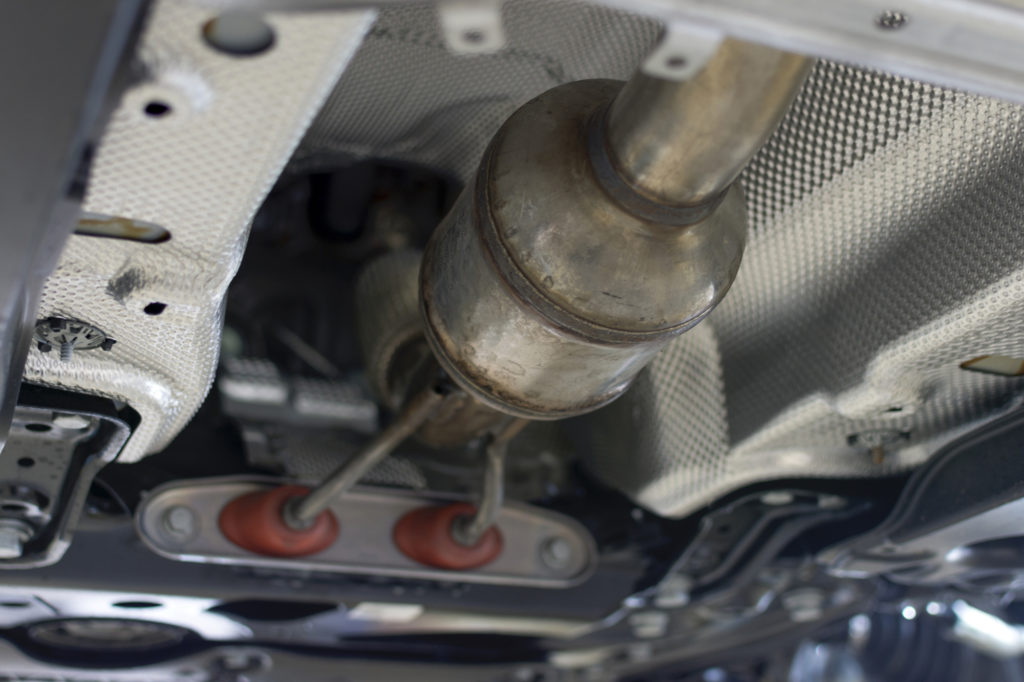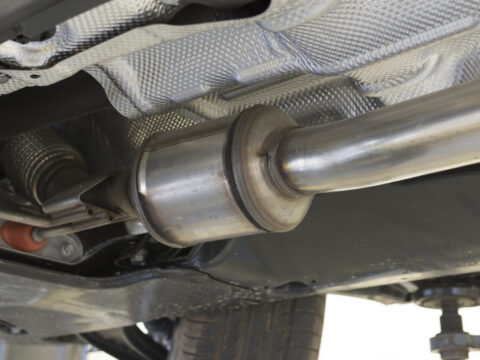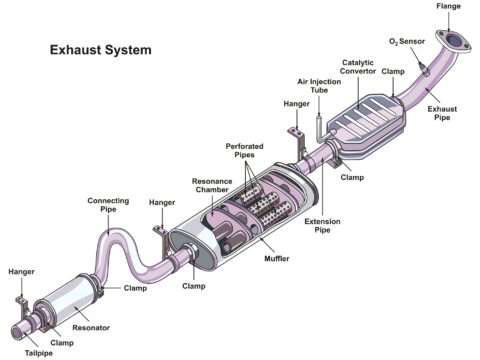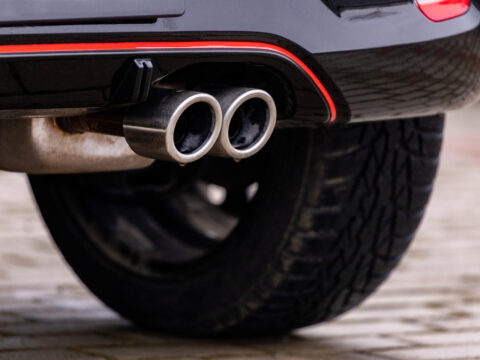A bad catalytic converter can affect your vehicle’s performance. Understanding the signs of its poor condition is key to getting it diagnosed and fixed quickly. The most obvious sign is your check engine light or sensor warning, but there are other ways to figure out if your catalytic converter needs replacing.

Contents
What Does a Catalytic Converter Do in a Car?
Every street-legal vehicle has a catalytic converter. The purpose of a catalytic converter is to “scrub” your vehicle’s exhaust and turn the hydrocarbons, carbon monoxide, and nitrogen oxide into carbon dioxide, nitrogen, and water vapor. A focus on environmental cleanup in the 1970s led to clean air initiatives, and the catalytic converter represented a way to purify emissions.
The way a catalytic converter works is that a catalyst inside the converter reacts with vehicle emissions and converts the emissions to less dangerous substances. To do this, temperatures must be extremely high. That is why manufacturers placed the converter, which looks like a loaf of bread, close to the engine.
How Do You Know if You Have a Catalytic Converter Problem?
Usually, you will know you have a bad catalytic converter because the “check engine light” will come on. The warning light should be solid. If it is flashing, you must get your vehicle to a mechanic as soon as you can. A bad catalytic converter, however, will always present a solid check engine light.
Another way to tell if your catalytic converter is failing or bad is to observe it after running the engine for about 20 minutes. A bad converter will glow red when exposed to high heat from the engine and exhaust.
How to Diagnose a Bad Catalytic Converter
The method of diagnosis of a bad catalytic converter is simple. The easiest way is to take your vehicle to a mechanic and have them test it. If the catalytic converter is bad, they will get a computer error of P0420 or P0430. Here is the way to diagnose it on your own.
Test Drive
Take the vehicle out for a test drive. Pay attention to how it performs when the vehicle is
- Moving
- Stationary but not parked
- Parked but still engaged
Check whether the vehicle hesitates as it runs. Try and tell if the engine is misfiring first or if it is running smoothly but misfiring as a reaction to something.
Inspect the Tailpipe
Turn the vehicle on and take a look at the exhaust coming out of the tailpipe. Is it black, blue or white? Each indicates a problem with your engine that warrants a mechanic checking it out. Here is what each color means:
- Black: The engine is running rich, meaning too much fuel is getting into the engine
- Blue: The engine is burning oil
- White: There is a coolant leak somewhere
What this means is that your catalytic converter is not heating up enough to alter the composition of some dangerous emissions.
What Does a Bad Catalytic Converter Look Like?
A bad catalytic converter will glow bright red after you have run your vehicle for a while. You should run the vehicle for at least 15 minutes, then look for a glowing red band underneath the vehicle. If the converter glows that color, it means that the catalytic converter is clogged or fuel is burning in the filter, likely because of a bad spark plug or ignition coil.
Trying to see if your catalytic converter is glowing red is not a test you should do by yourself. A mechanic is the best person to do it or at least supervise it. The temperatures you would be dealing with are high and climbing under a car with red hot components is not a good idea.
Symptoms of a Bad Catalytic Converter
There are several symptoms beyond climbing under a hot vehicle that will prove your catalytic converter needs help. Because the issue might be something else, you should perform each step to build a strong argument that your catalytic converter is bad.
Vehicle Will Not Start
Bad catalytic converters rarely cause engine failure. In some cases, though, a restricted converter can create enough back pressure to keep the engine from starting.
Vehicle Starts Misfiring
This problem happens with bad catalytic converters and other engine ailments. When a converter becomes clogged with carbon, emissions return to the engine. When that happens, the backpressure affects the combustion process. A disrupted combustion process makes the engine run unevenly.
Weak Acceleration
When you press the gas pedal and your vehicle speeds up slower than usual, it might be a sign of a bad catalytic converter. Your acceleration might also pause for a second, almost as if the vehicle stalled.
Poor Performance
Your gas mileage will drop quickly. The vehicle will have less power.
Rattling
If your catalytic converter is cracked or otherwise damaged, it can make a rattling sound. The casing can crack, which can cause vibrations along the tailpipe that cause it to rattle. Internally, the honeycomb mesh can collapse or shatter, which also causes a rattle.
You likely will hear the rattle when you start the vehicle versus run it.
Rotten Egg Smell
Combustion creates hydrogen sulfide. A catalytic converter in good order will convert that gas into odorless sulfur dioxide. When the converter breaks, you will smell hydrogen sulfide escaping through the tailpipe. Hydrogen sulfide escaping will also usually be accompanied by darker than usual smoke.
Failed Emissions
Not passing an emissions test is the most painless way to tell if you have a catalytic converter problem. If you do, it likely needs replacing, which is where the pain begins. Your mechanic can run a diagnostic and emissions test on your vehicle and determine if your catalytic converter is working. If you fail, the catalytic converter is a likely culprit, or at least it presents a troubleshooting starting point.

What Causes a Catalytic Converter to Go Bad?
There are multiple ways a catalytic converter can go bad. Here is a rundown of the most common.
Age
Some older cars have catalytic converters that break simply due to age. Most catalytic converters last between 70,000 and 100,000 miles. Some well-kept vehicles can get more.
Impact
It is rare, but if your vehicle experienced damage in an accident or you went off-road driving, you can damage and break your catalytic converter. The converter sits so high up near the engine, though, that if you damage it that way, chances are good you have additional, extensive damage to your vehicle.
Poor Engine Maintenance
Neglecting your vehicle can lead to an environment that promotes your catalytic converter breaking or wearing out. The most pronounced risk in this regard is that neglecting maintenance will prevent you from seeing factors that can influence the degradation of a catalytic converter, and you will not discover there is an issue until the converter needs replacing.
Other Engine Issues
Malfunctioning spark plugs, coolant leaks, and seal issues are all possible factors in a catalytic converter failing. Each contributes to wear and tear and the catalytic converter clogging.
Bad Oxygen Sensor
Sometimes sensors wear out or get damaged. You should always check that before doing any major work on your vehicle. Usually, your mechanic tests the emissions, and if those are within a compliance range, the issue is your oxygen sensor.
Can a Bad Catalytic Converter Cause Damage to Your Car?
Theoretically, a bad catalytic converter will not harm your engine if you get it taken care of promptly. A bad catalytic converter will reduce your vehicle’s performance, kill your fuel efficiency, and you will not pass inspection.
A broken catalytic converter will not damage your engine, but it will increase the wear and tear your engine experiences. A clogged catalytic converter will trap exhaust gases, which increases pressure and heat on the exhaust system. That increased pressure and heat will increase the wearing of the exhaust system components and surrounding parts.
Can You Still Drive Your Car with a Bad Catalytic Converter?
Yes, but only for the short term. As you drive, you will probably experience performance issues, but a bad catalytic converter will not damage your engine in any meaningful way. You will need to replace your catalytic converter or get a new vehicle before your next inspection deadline.
What to Do with a Bad Catalytic Converter?
The first step is to take it to your mechanic and verify the converter is the problem. A broken catalytic converter will need replacing as most repairs are temporary at best.
How Much Will It Cost to Fix a Bad Catalytic Converter?
The cost to fix a catalytic converter depends on the make and model of your vehicle. It costs less to replace catalytic converters in older vehicles. You can get lower-quality catalytic converters to save on costs.
Usually, the low end runs about $800, counting parts and labor, but you can spend into the thousands if you want high-end parts.














